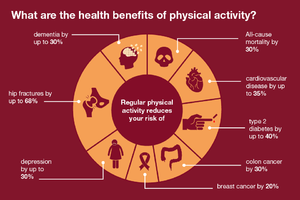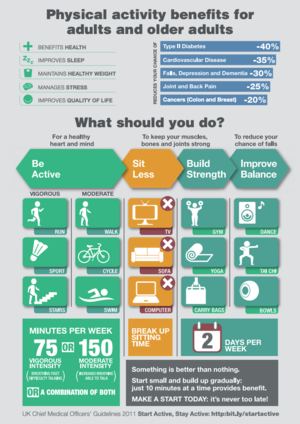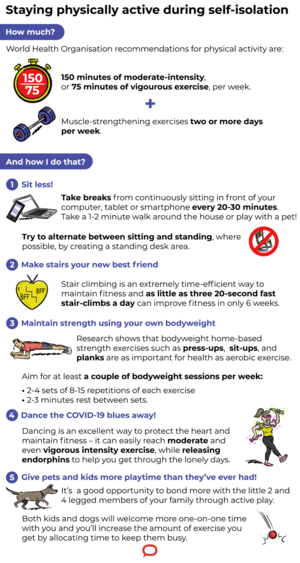Physical Activity and COVID-19
This article or area is currently under construction and may only be partially complete. Please come back soon to see the finished work! (8/05/2020)
Original Editor - Your name will be added here if you created the original content for this page.
Top Contributors - Wanda van Niekerk, Kim Jackson, Vidya Acharya, Lucinda hampton, Laura Ritchie, Oyemi Sillo and Jess Bell
Introduction[edit | edit source]
The COVID-19 pandemic is an unprecedented time all across the world. Worldwide, extensive social distancing policies are put into place, restricting people’s daily activities and worldwide pleas from governments asking people to stay safe and stay at home. This of course means that most people will spend much of their time (if not all) at home.
These social distancing measures mean that people have far fewer opportunities to be physically active, especially if activities such as walking or cycling as transportation means or taking part in a leisurely sports activity (i.e. jogging, walking the dog, going to the gym) are being restricted. Furthermore, these drastic measures also make it so much easier to be sedentary at home for long periods of time.[1] The impact of this physical inactivity may very likely be seen in many areas such as health and social care and the mental well-being of people all across the globe.
Although these social distancing measures are important and needed in a time such as now, our bodies and minds still need physical activity and the many benefits thereof.
Definition of Physical Activity[edit | edit source]
Physical Activity (PA) is defined as any bodily movement produced by skeletal muscles that require energy expenditure.[2] There are two components to Physical Activity that needs to considered:
- Aerobic fitness: this usually includes moderate to vigorous activity that makes you feel a bit warm, causes your breathing to increase and your heart rate to increase.
- Strength and balance: This is often the forgotten component of physical activity, but it is an essential part and has many benefits.
Physical activity may include[3]:
- Active recreation
- Sports participation
- Cycling
- Walking
- Play
- Dance
- Gardening
- House cleaning
- Carrying heavy shopping
During the COVID-19 pandemic it is even more important for all people to be physically active. Even if it is only a short break from sitting at your desk and doing some walking or stretching. Doing something simple as this will[3]:
- ease muscle strain
- relief mental tension
- improve blood circulation
- improve muscle activity
- It also helps to give some routine to a day in these unprecedented times.
Benefits of Physical Activity[edit | edit source]
There are many benefits of physical activity. These include:
- Keeps your immune system strong - being less susceptible to infections[4]
- Reduces high blood pressure
- Weight management
- Reduce the risk of heart disease
- Reduce the risk of diabetes
- Reduce the risk of stroke
- Reduce the risk of certain cancers
- Improves bone and muscle strength
- Improves balance
- Improves flexibility
- Improves fitness
- Improves mental health
- Reduce the risk of depression
- Reduce the risk of cognitive decline
- Delay the onset of dementia
- Improve overall feeling of well-being
- In children physical activity may:
- support healthy growth and development
- reduce the risk of disease in later life
- help in development of fundamental movement skills
Despite all these many benefits, physical inactivity costs 5.3 million lives per year globally.[5] It is important therefore to find ways to limit the impact of the COVID-19 pandemic as well as the wider impact it will have on long term chronic diseases.[1]
The Importance of Physical Activity during the COVID-19 Pandemic[edit | edit source]
In light of the current situation worldwide, certain benefits of physical activity may be pertinent to the COVID-19 Pandemic. These benefits are:
- Physical activity enhances immune function and reduces inflammation, it could therefore reduce the severity of infections.
- Physical activity improves common chronic conditions that increase the risk for severe COVID-19 (i.e. Cardiovascular Disease, Diabetes).
- Physical activity is a great stress management tool through reducing symptoms of anxiety and depression.
- Physical activity helps bring cortisol levels in balance - Stress and distress (such as during a pandemic) creates an imbalance in cortisol levels and this negatively influences immune function and inflammation.
Physical Activity Guidelines[edit | edit source]
The WHO Guidelines on the amount of physical activity include:
- Infants under the age of 1 year need to be physically active several times a day.
- Children under 5 years of age should spend at least 180 minutes a day in physical activities, with 3-4 year-olds being moderately or vigorously active for an hour a day.
- Children and adolescents aged 5-17 years
- all children and adolescents should do at least 60 minutes a day of moderate to vigorous-intensity physical activity, including activities that strengthen muscle and bone, at least 3 days per week.
- Adults aged over 18 years
- should do a total of at least 150 minutes of moderate-intensity physical activity throughout the week, or at least 75 minutes of vigorous-intensity physical activity throughout the week, including muscle-strengthening activities 2 or more days per week.
- older adults with poor mobility should do physical activity to enhance balance and prevent falls on 3 or more days per week.
Important: Any physical activity is better than none!!!
During the COVID-19 pandemic being physically active will be a challenge for all of us, but it is critical that we find and plan ways to be active and reduce our sedentary time. Although our movement around our neighbourhood, town, city, country and the world might be restricted, it remains critical that we all move more and sit less.
Ways to Stay Physically Active during COVID-19[edit | edit source]
How to Stay Safe while Exercising during COVID-19[edit | edit source]
Resources[edit | edit source]
- bulleted list
- x
or
- numbered list
- x
References[edit | edit source]
- ↑ 1.0 1.1 https://theconversation.com/how-to-stay-fit-and-active-at-home-during-the-coronavirus-self-isolation-134044
- ↑ World Health Organisation. Physical Activity. Avalaible at: https://www.who.int/dietphysicalactivity/pa/en/ [last accessed 6 April 2020]
- ↑ 3.0 3.1 World Health Organisation. Be Active During COVID-19. Available from https://www.who.int/news-room/q-a-detail/be-active-during-covid-19 [last accessed 6 April 2020]
- ↑ Nieman DC, Henson DA, Austin MD, et al. Upper respiratory tract infection is reduced in physically fit and active adults. British Journal of Sports Medicine 2011;45:987-992.
- ↑ Lee IM, Shiroma EJ, Lobelo F, Puska P, Blair SN, Katzmarzyk PT, Lancet Physical Activity Series Working Group. Effect of physical inactivity on major non-communicable diseases worldwide: an analysis of burden of disease and life expectancy. The Lancet. 2012 Jul 21;380(9838):219-29.
- ↑ Sallis, JF. Physical activity + COVID-19. Lecture to UC San Diego medical students. March 2020. Published on 1 April 2020. Available from https://www.youtube.com/watch?v=F4mcbi9tD-M. [last accessed 10 April 2020]









